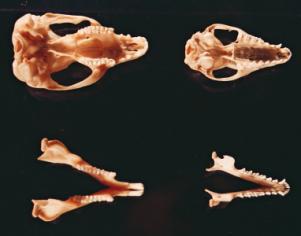
AUSTRALIAN MARSUPIALS
SUPER COHORT MARSUPIALIA
COHORT AUSTRALIDELPHIA
 A small 'mob' (social group) of kangaroos foraging peacefully in the late afternoon spring sunshine in South Australia. The female at the left back carries a joey in her pouch. |
The earliest Australian marsupials (24 mya) were arboreal or terrestrial forest animals, as are the majority of species, i.e. 50 out of 83 species, living in the mountainous areas of New Guinea and Northern Australia today. As the forests contracted due to climatic changes, the savanna woodlands and grasslands which superseded them favored an explosive radiation of grazing kangaroos.
Today, Australian marsupials occupy similar niches to placental mammals elsewhere: there are insectivores, herbivores, carnivores and omnivores. They are found in all terrestrial habitats, from rain forests, to deserts and high alpine areas; only 30 out of 155 species are arboreal.
Australian marsupials are extraordinary diverse: the smallest, the long-tailed planigale, weighs less than 4.5.grams; the largest, the male red kangaroo, weighs 95 kg. This diversity is reflected in the variety of skulls and dentition that evolved as marsupials adapted to different habitats and new foodstuffs.
| Origin and evolution of Marsupials |
The marsupials of Australia and New Guinea appear to have
diverged into three main evolutionary lineages in the Cretaceous and
Paleocene periods, some 50 - 80 mya.
 Under sides of skulls and lower jaws of a diprotodont (left) and a polyprotodont (right) show dentition, in particular the lower incisors. |
Eight of the fifteen extant families of Australian marsupials and the extinct family Thylacinidae are represented in our Collections.
| Bandicoots | Dasyurids | Marsupial moles |
| Thylacine | Koala | Wombats |
| Kangaroos | Possums | Feathertail or pygmy glider |
We are do not have specimens of members of the other seven extant familes: honey possums (family Tarsipedidae), numbats (family Thylacomyidae), ringtail possums (family Pseudocheiridae), pygmy possums (family Burramydiae), the musky rat kangaroo (family Hypsiprymnodontidae), gliders and striped possums (family Petauridae), spiny bandicoots (family Peroryctidae).
| INTRODUCTION TO MARSUPIALS | AMERICAN MARSUPIALS | MONOTREMES |






